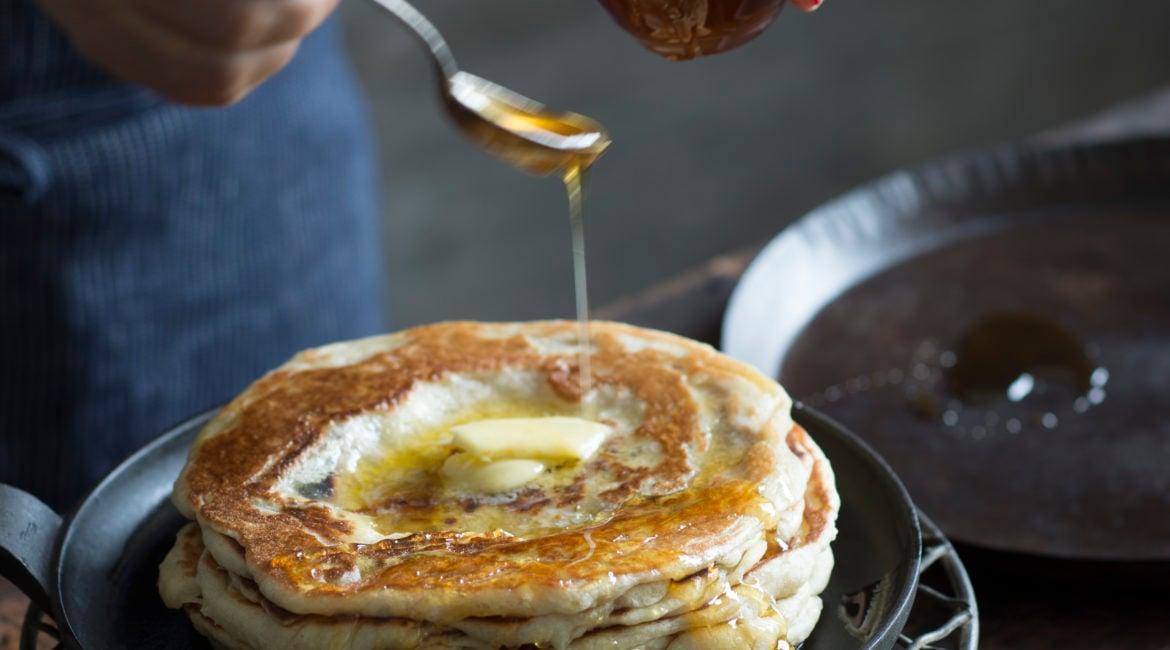Mufleta: Stacked Yeasted Pancakes

We had all heard whisperings about this incredible thing called ‘mufleta’ (often known as mofletta, as well as mofleta, moufleta and מופלטה in Hebrew) which we knew of as some sort of pancake with a secret recipe made by the Moroccan Jews to mark the end of Passover and Mimouna.
So when Elizabeth Schwartz, a Yiddish singing klezmer artist (among other things) from NYC, shared her recipe with us, we were excited. And when we made it together in the MMCC kitchen and it actually worked the very first time, we were beyond excited!
They are yeast pancakes, made of soft dough and fried on one side only; the second side of each pancake cooks as it lies on top of a growing stack of hot mufletas right in the pan. We stood around and literally tore them to bits, not being able to stuff them in our mouths fast enough, soft, yeasty crumpet-like pancakes, dripping in butter and honey.
The feast known as Mimouna begins at sunset on the last day of Passover (on Sunday evening this year) and ends at nightfall the following day. It was traditionally celebrated by Jewish communities of North African descent (mainly Moroccan but also Algerian, Tunisian, Libyan and Egyptian) but has now spread across Israel and some parts of the world particularly to the Sephardi and Mizrahi communities. The feast celebrates the return to eating ‘chametz‘ (leavened bread etc) which was forbidden during the previous 8 days of Passover.
We first published this recipe and story in our third book, It’s Always About the Food on p. 56.
And if you’re always looking for great, weeknight dinner ideas, why not join our next masterclass, ‘Weeknight Workout: Salmon + Salsa’ ? We hope to see you then!

Mufelta: Stacked Yeasted Pancakes
Ingredients
- 7 g (1 sachet) active dried yeast (2 1/4 teaspoons)
- 375 ml warm water (1½ cups)
- 500 g Plain (All purpose) Flour (3 1/3 cups)
- 2 teaspoons sea salt
- 2 heaped tablespoons white sugar
- 125 ml light olive or grape seed oil ½ cup
- butter and honey to serve
- butter and honey to serve
Instructions
- In the bowl of an electric mixer with a dough hook, or in a mixing bowl, combine the yeast, water and 1/4 cup of the flour and allow to stand for 5 minutes, or until the mixture foams.
- Add the remaining flour along with the sugar and salt. Knead the dough for 5 minutes in the electric mixer or 8 - 10 minutes by hand. It will be a very sticky dough. Cover the bowl with a damp towel and let the dough rise for about 1 hour or until a little more than doubled in size.
- Pour 3/4 of the oil into a small bowl. Spread the remaining oil onto a large rimmed baking tray. With a knife, divide the dough into 12 equal pieces. Lightly dip your hands in the oil and, with greased hands, shape each piece into a ball. Dip each ball quickly into the bowl of oil and place the balls on the oiled tray. Cover again with the towel and allow to rise for 30 minutes.
- Grease a medium frying pan and your benchtop with the oil. Set the pan over medium-high heat.
- With oiled hands, take a ball of dough, place it on the oiled bench top and flatten it with stroking, outward motion into a thin, nearly translucent disc of about 20 cm (8 inch) diameter.
- Place the circle of dough in the hot pan and cook for about 3 minutes until it browns slightly underneath. Meanwhile, make another disc with the next ball of dough. After this point, you won’t need to oil the pan, since the dough will provide enough oil.
- Flip the first pancake over and place the second one on top of it, on the just-cooked side. Let it cook for a minute or so until the underside is golden, then turn over both the pancakes together (now the new pancake will be facing down, and the first one facing up). Place a new circle of dough on top of the stack, and flip the whole thing. Repeat with the remaining dough so that you have a stack of 12 pancakes in the end. Once you remove the mufletas from the pan, cover them quickly with a towel, so they stay hot and moist. Serve immediately with butter and honey.





it’s actually called Mofletta – not mufelta. Surprising in this day and age you guys haven’t fact checked. Especially, when you’re posting some other cultures stuff. takes 2 seconds to google it. Ignorance is a choice. Please don’t disrespect other cultures for the sake of getting content on your website.
Thanks for your comment Ibn. No disrespect was meant in any way and I don’t believe we are disrespecting other cultures in any way. There are often many spellings for the one thing and different parts of different groups are allowed to spell things as they wish (for e.g chanukah is spelt many different ways when written in English). This recipe was given to us by someone who spells it ‘mufelta’ and so that is how we share and pass on the recipe. And as Wikipedia says: Mofletta (Hebrew: מופלטה, also Mufleta, Mofleta, Moufleta etc.).
And I have now added in the other spellings of the dish.
Lisa, while there are a number of spellings transliterated into English, mufelta isn’t one of them, and if it came to you that way it probably originated in sometime transcribing a beloved relative’s handwriting wrong. Or from a simple typo. You should check with your source rather than allowing this recipe to stand, and the wrong spelling, which affects pronunciation, encouraged to spread around the internet with links back to sbs.
I think you owe Ibn Khaldun an apology for your defensiveness.
*Someone not sometime
I get that people are pressed about the spelling but this is an amazing recipe. You guys should try it out.